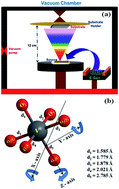Physical vapor deposited highly oriented V2O5 thin films for electrocatalytic oxidation of hydrazine†
Abstract
The proposed work is focused on the effect of substrates on the electrocatalytic performance of physical vapor deposited vanadium pentoxide (V2O5) films. V2O5 thin films were prepared onto various substrates such as glass, indium doped tin oxide (ITO), fluorine doped tin oxide (FTO), aluminum (Al) and copper (Cu). XRD patterns revealed that the evaporated V2O5 films were a single crystalline orthorhombic structure with the predominant orientation along the (001) lattice plane. In order to understand the influence of substrates' effect on the structural properties, various microstructural parameters such as crystallite size (D), dislocation density (δ), microstrain (ε) texture coefficient and stacking fault probability (α) for preferential orientation were evaluated and discussed in detail. Tauc's plot was used to determine the band gap of V2O5 thin films and found to be 2.1 eV for the film deposited on the ITO substrate. SEM and AFM analyses revealed that physical vapored V2O5 thin films are densely packed with uniform morphological and topographical features. Significantly, to the best of our knowledge; the feasibility of V2O5 thin films for the electrochemical performance towards the detection of hydrazine oxidation was demonstrated for the first time using cyclic voltammetric studies. V2O5 thin films coated on ITO substrates exhibited better catalytic activity with a mass catalytic activity of 3320 mA g−1. These findings will provide a new avenue for electrocatalytic activity of hydrazine oxidation based on V2O5 thin films and will be extremely important for the selection of a suitable substrate in the field of sensor and actuator technology.


 Please wait while we load your content...
Please wait while we load your content...